Dick Landy: Dodge’s Hero Drag Racer – Part 2
Last time, we covered Dick Landy’s earlier years in drag racing, and this Part II segment takes a look from 1970 Pro Stock involvement through the early 1980s.
PRO STOCK: NEW FOR 1970
By the time 1969 had rolled around, there were four drag racers that brainstormed and came up with a new “heads-up” no-handicap racing formula, and presented it to the NHRA, and they bought the idea. The basic rules were as follows: stock frames, factory-produced vehicles (no tube chassis) that ran a weight factor of 7.0 pounds per cubic inch. So in the case of a Mopar® with a HEMI® engine, the weight was right at 3,000 pounds. The group was Dick Landy, Ronnie Sox, Bill Jenkins and Don Nicholson.
As one of the “founding fathers” of NHRA’s new Pro Stock Class for 1970, Landy represented Dodge’s factory effort on the track. Hot Rod magazine got wind of this new class and directly asked Landy about it.
“I like the heads-up Super Stock racing, and I couldn’t be happier now that NHRA has created this new eliminator. I like to drive a car with a lot of power but I can’t get excited over playing catch-up with a SS/JA car and having to hit the brakes for fear of breaking out. I don’t like to play guessing games; I like to go as fast as I can and win by using driving technique and horsepower – not the brakes. I personally feel this new heads-up thing is going to be one heck of a show, because the cars now have some place to run. More guys will be building them, and the eliminator will become more competitive all the time.”
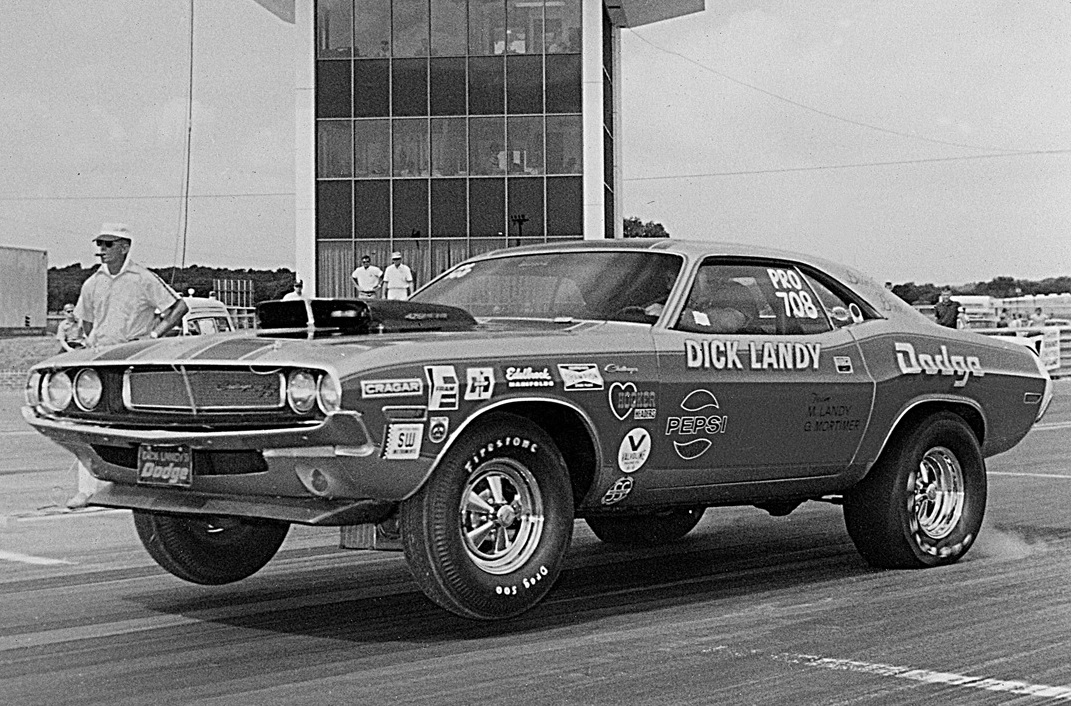
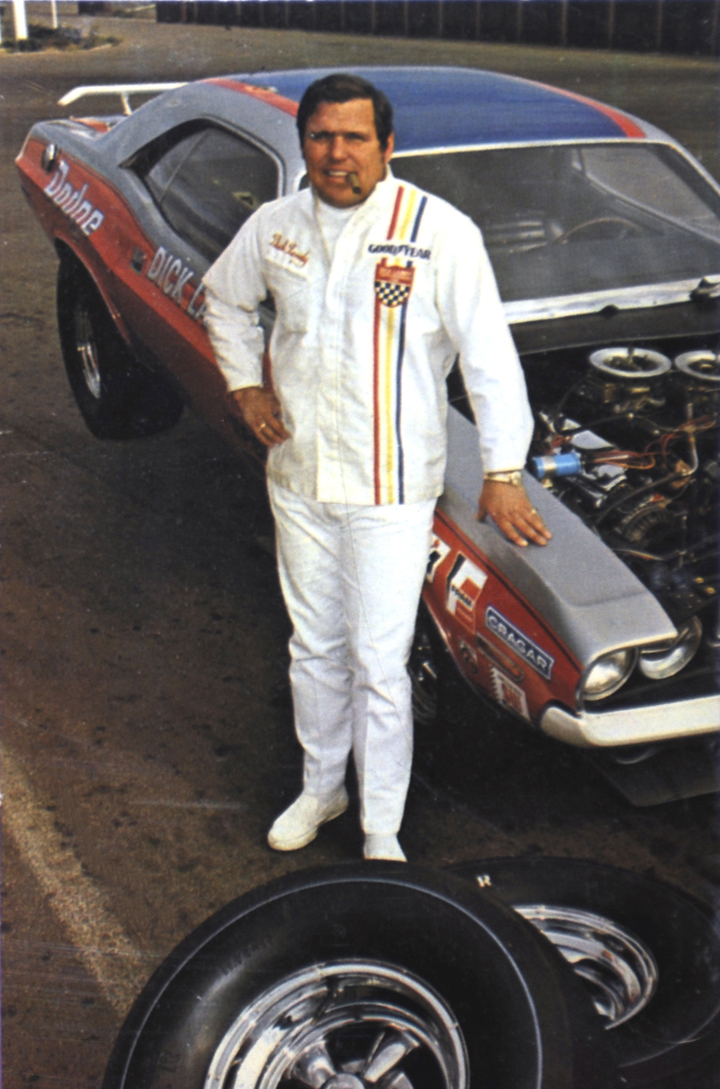
Popular Hot Rodding magazine also had met up with Landy to talk about the season to come, with this report:
“For the 1970 season, Landy will be running a two-car team, a 1970 Challenger and a 1970 Dart, both HEMIs. Landy is big, unabashed and never afraid to express his opinions. The cigar chomping veteran of the drag racing wars is the master of the psyche. To answer the call for more horsepower, Landy has been experimenting with a revolutionary new type of head. It is an all-aluminum casting that was modified by Landy.”
When the question was asked on ‘why’, here’s what Landy had to say: “The main reason for this is to obtain a wider flame front. In other words, you can burn cleaner during the power stroke of the engine, and you’re able to run less spark lead, around 30 degrees total.”
As he explained, besides the Challenger, he had prepared a Dart Pro Stocker as well, which was driven by Landy Team Member Bob Lambeck. Super Stock & Drag Illustrated magazine was curious about that and asked Landy specifically what the deal was by asking if he ran the Challenger strictly because of factory pressure?
“I have a ’70 Dart that’s finished. I didn’t think it would work as well as it does, and we were all surprised by it. But evidently, the center of gravity is down quite a bit in the Challenger, and it comes out better without going straight up. It wants to go forward. If the Dart would go faster, I’d have it with me at the major races. Factory pressure is one thing, but you’ve got to try to win races.”
In the photo of him standing next to his car, the HEMI engine-powered car was still equipped with the A-990 cross-ram intake manifold, soon to be replaced with an individual runner tunnel ram and twin Holley Dominators.
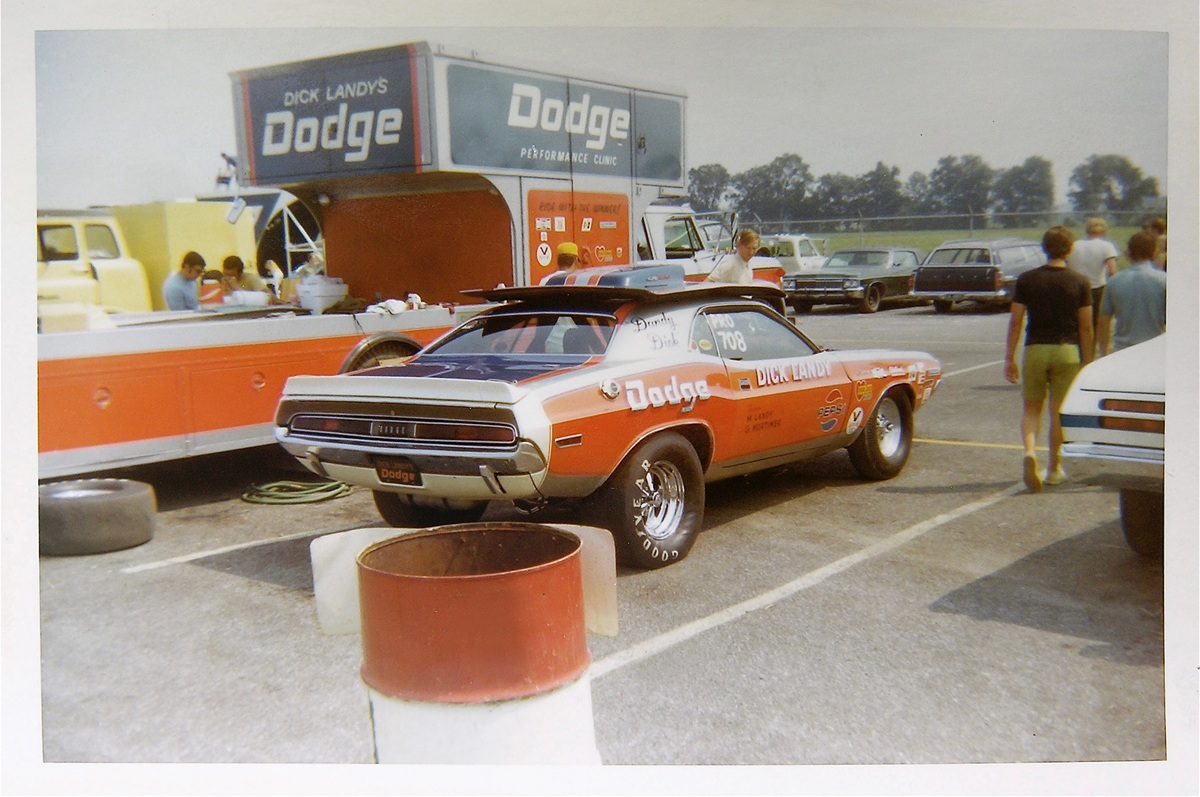
The summertime of 1970, the Pro Stock pits and Landy’s Challenger being serviced. At this point in the season, he had begun running the newly released Cragar “Super-Trick” spun aluminum front racing wheels, much lighter than the previous Cragar S/S five-spoke wheels. Note the fitting of the T/A rear spoiler on the decklid.
SUMMERNATS WINNER
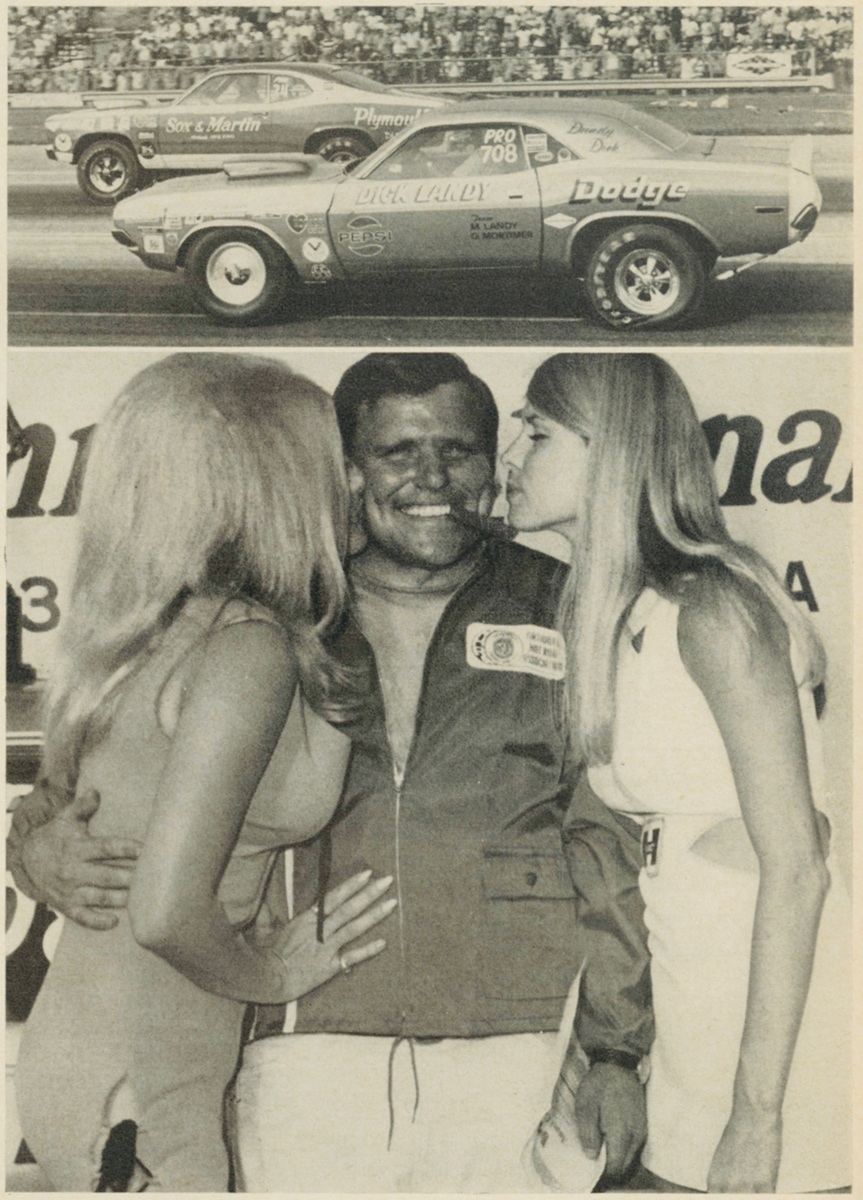
He did score a national event win with the ’70 Challenger, taking home first place at the 1970 NHRA Summernationals at York, PA, shown here being congratulated by Hurst’s Linda Vaughn and Nikki Phillips.
1971
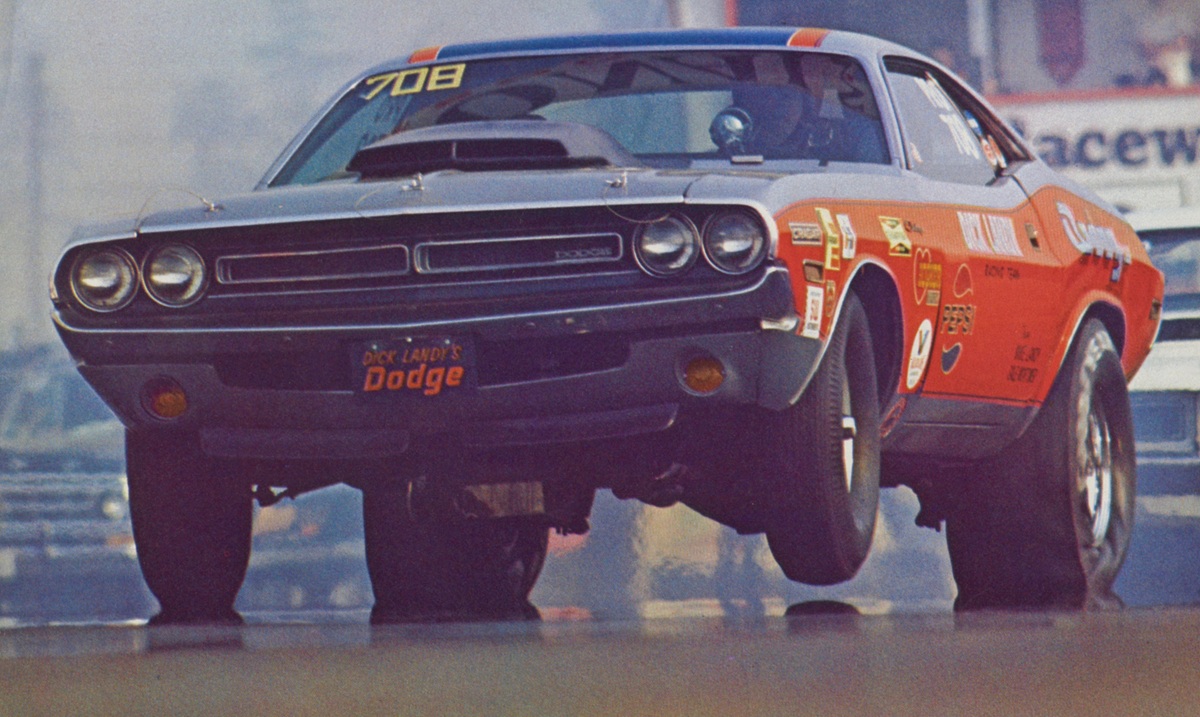
Shown here launching at Pomona, the ’71 Pro Stock Challenger Landy ran for the season (it was the ’70 car updated to ’71 grille and taillights), now fitted with a modified, bulged-over ’70 T/A Challenger type boundry-layer hood scoop and T/A front spoilers. One of the modifications he had done to it from the previous season was incorporating rack-and-pinion steering (from a UK-built Plymouth Cricket).
HOOKER CIGAR PROMOTION
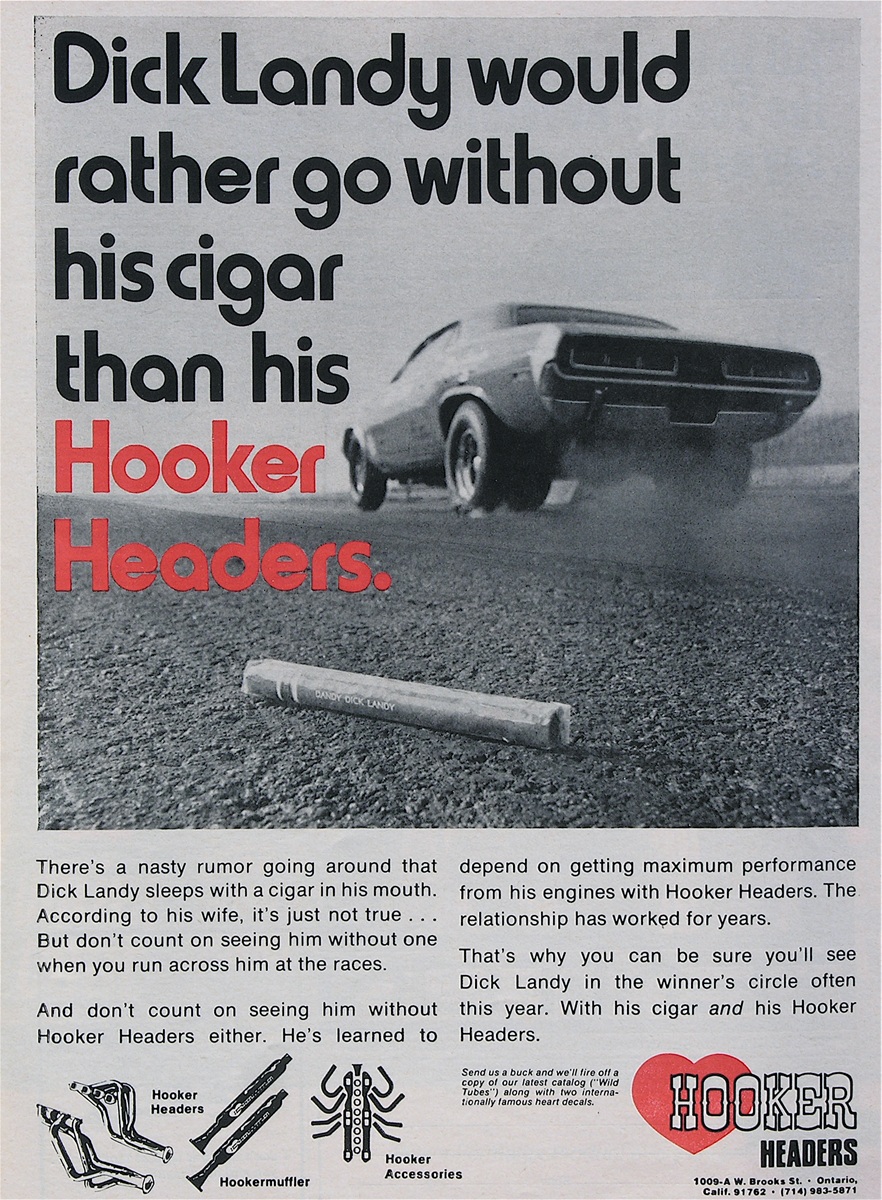
Hooker Headers had some creative advertising fun with their Dick Landy ad featuring one of his cigars on the track, with the ’71 Pro Stock Challenger launching in the background.
And the cigar was no marketing gimmick, most every picture of Landy at a drag strip has him with a cigar!
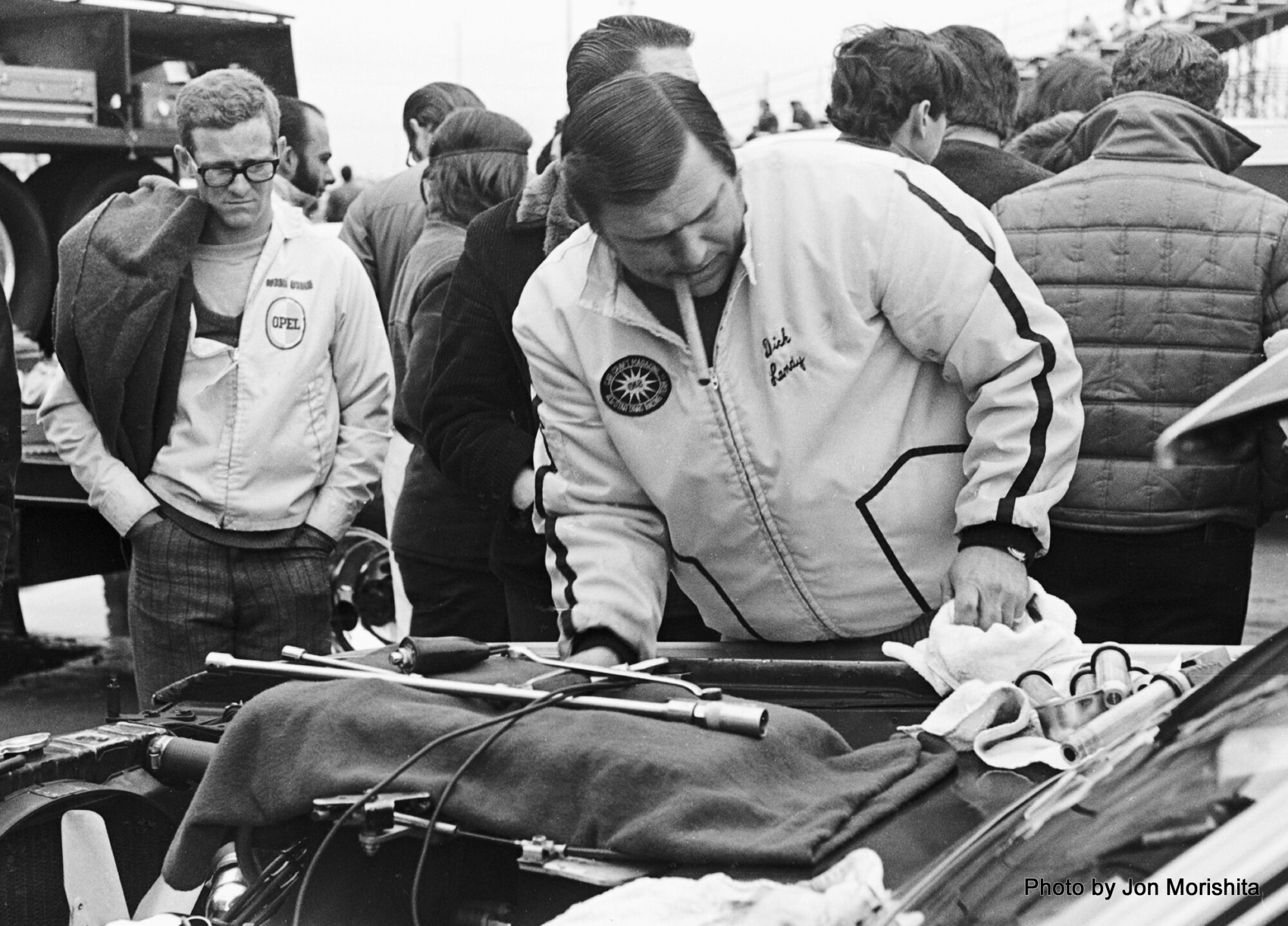
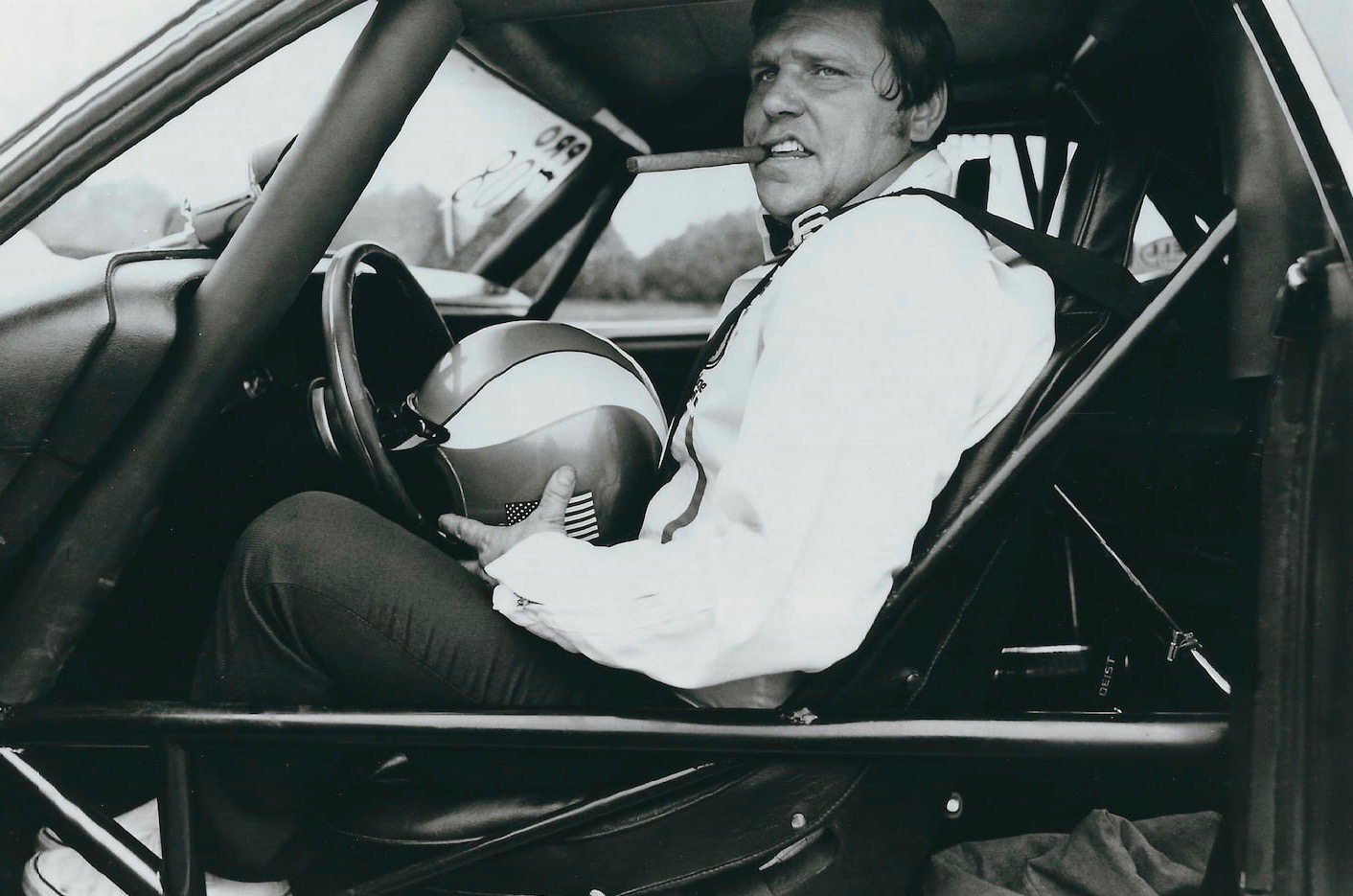
NEW LOOK FOR 1972
For the 1972 racing season, the Dick Landy Challenger Pro Stock had a completely, fresh and lively look! The first of his cars to utilize the tri-color paint scheme, in shades of red and blue, with white. The car was running in the 9.60 range at 144-plus mph.
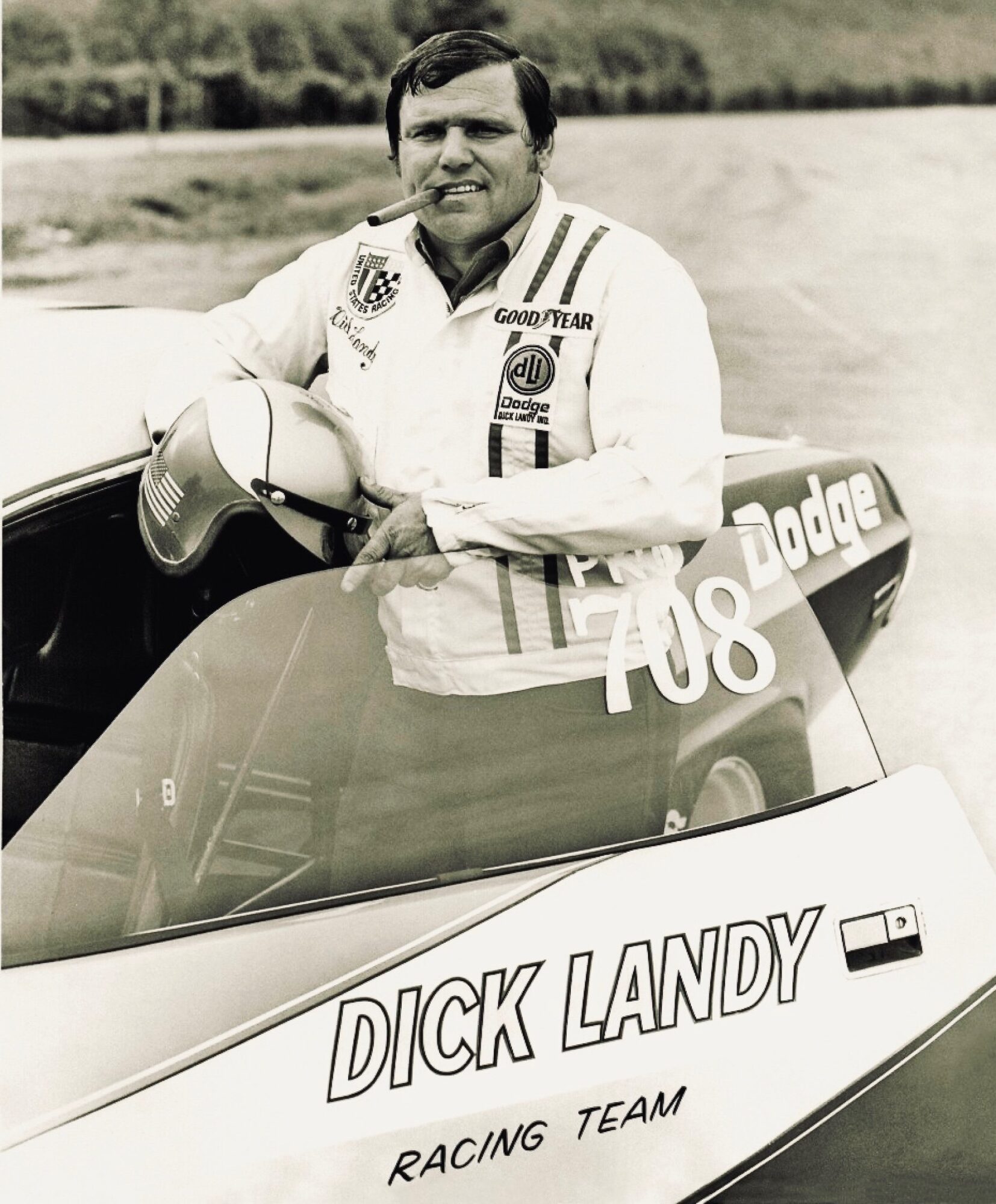
Dandy Dick with his trademark stogie, the patch on his right-hand shoulder is the “United States Racing Team” logo, a group that he ran with for Pro Stock match racing across the country. Throughout the summer, he’d be running on drag strips with the likes of Ronnie Sox, Bill Jenkins, Don Nicholson, Herb McCandless, Wayne Gapp and Wally Booth. There was a lot of action taking place besides racing with the NHRA!
1973: SWITCH TO DODGE DART SPORT PRO STOCK
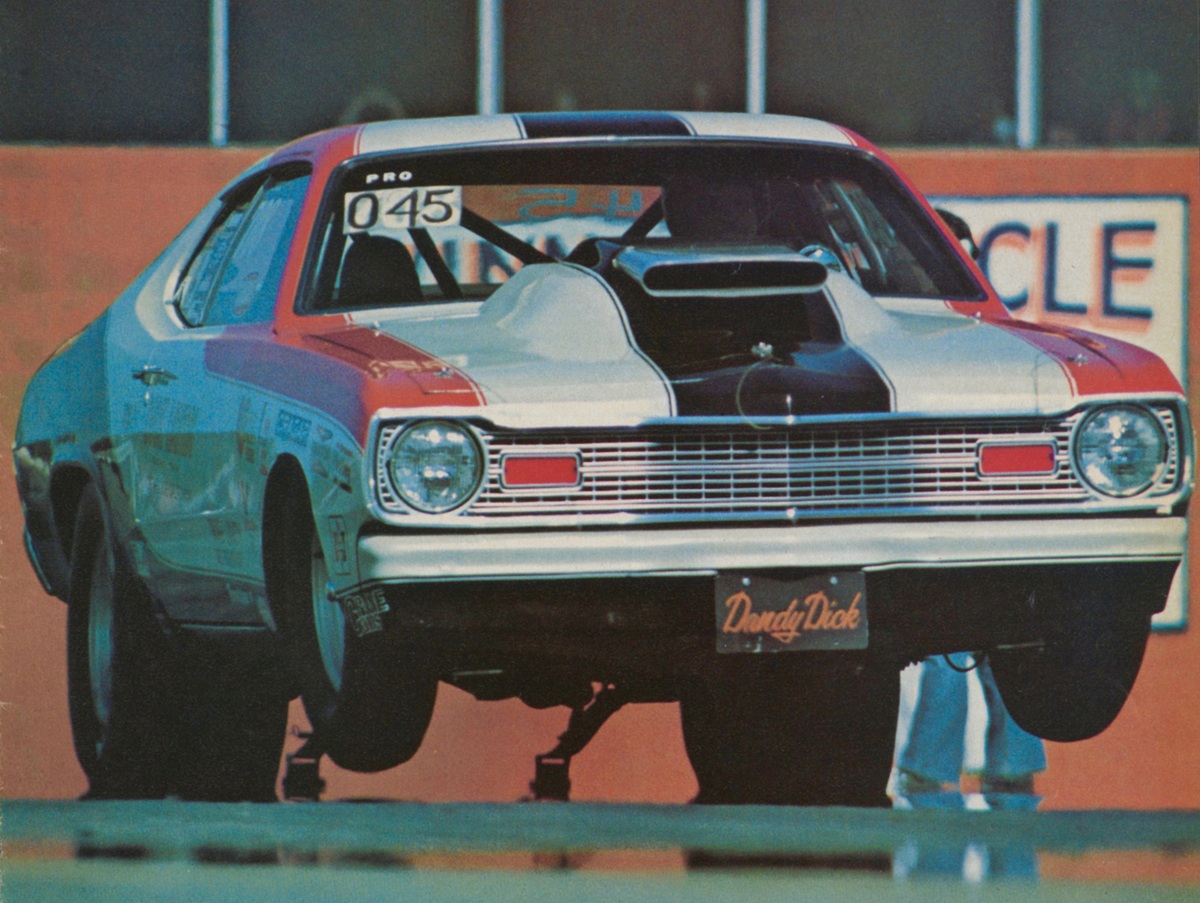
A decision was made to build a new car for 1973, and switch to the narrower Dart Sport body shell as compared to the wider E-body Challenger. Working with talented dragster chassis builder Kent Fuller, Landy went all out to construct a state-of-the-art machine and keeping things light was a priority. The reason: For match racing! Besides NHRA and AHRA, there were “run whatcha brung” showdowns where the cars could run as light as possible.
For the NHRA, where the rules had weight breaks between cubic inch displacement and overall weight, Landy found that de-stroking the 426 HEMI engine down to 404-cid resulted in less weight with nearly the same power output. A Moldex crankshaft with 4.210 bore achieved it. 13.5:1 compression pistons, M/T aluminum rods, Crane roller and dual Holley #6410 Dominators, Mallory Super Mag ignition, dry sump oiling and 2 1/4″ Hooker Headers. NHRA weigh was 2,575 pounds. Total cost was $32K.
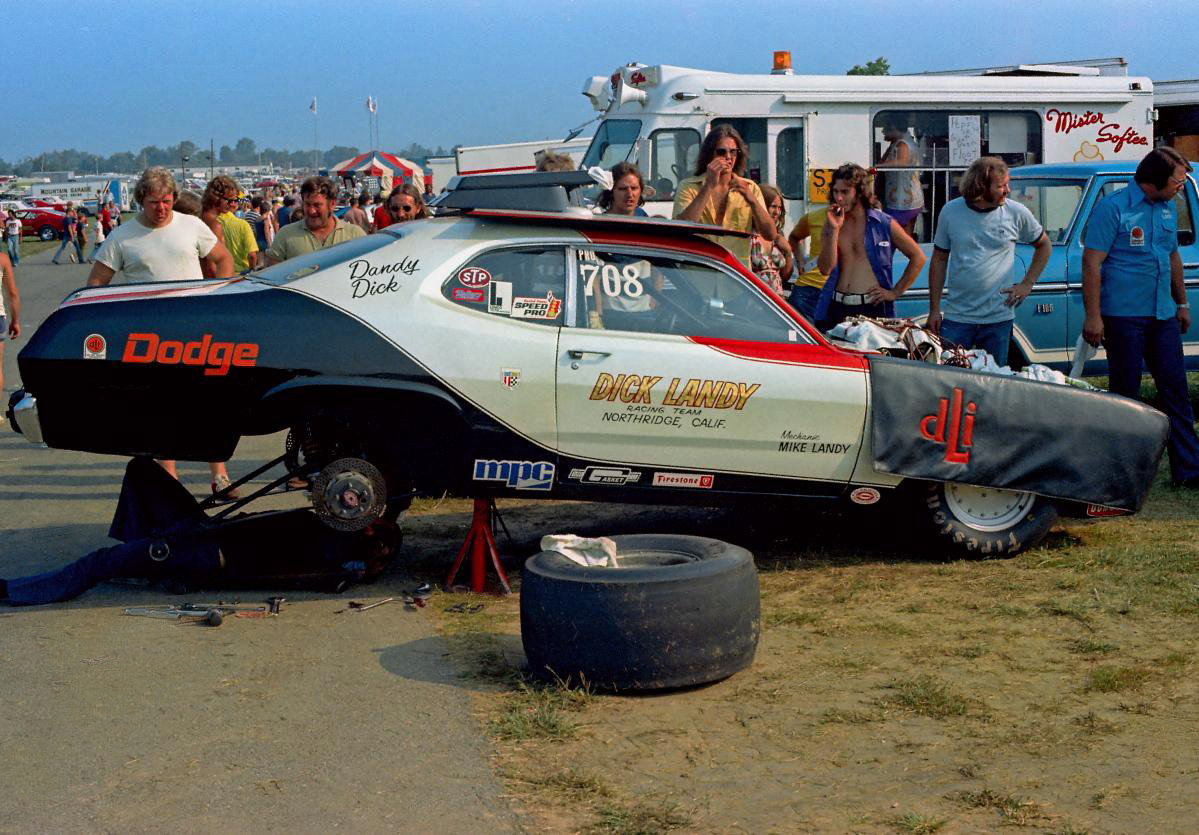
In 1973, he won the AHRA Pro Stock Championship, raced on the NHRA circuit, plus lots of match racing. At the time, the car ran 9-flat at 150 mph with a Mopar 4-speed, he chose not to run the Lenco at this early stage. Dana spool with either 5.38 or 5.57 gearing, depending on the track. Ladder bars, coil-over suspension.
DIRECT CONNECTION AD
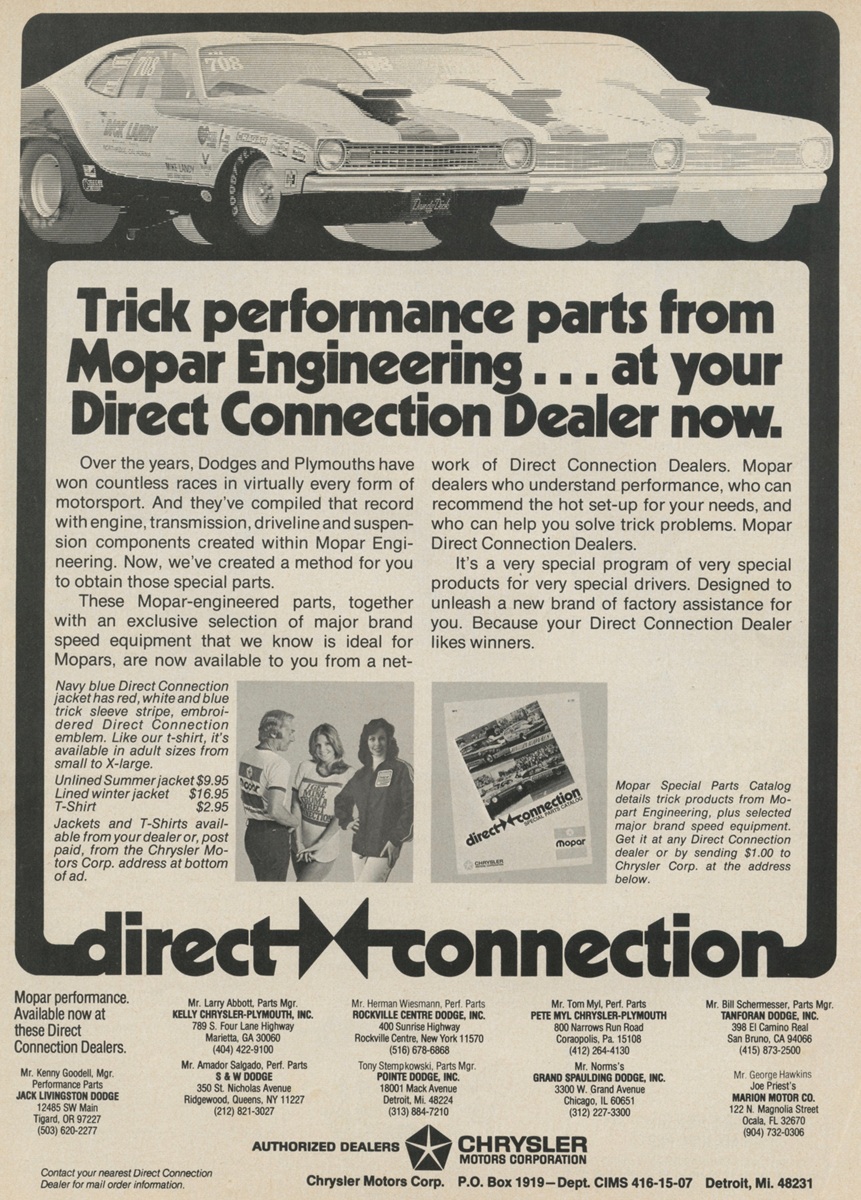
Mopar’s advertising agency was running full-page Direct Connection ads in the popular car enthusiast publications during this time frame; this August 1974 Car Craft featured the Landy Dart Sport. “Designed to unleash a new brand of factory assistance for you.” The ad listed the then nine Direct Connection Dealers located coast to coast.
1974: RETURN TO SUPER STOCK
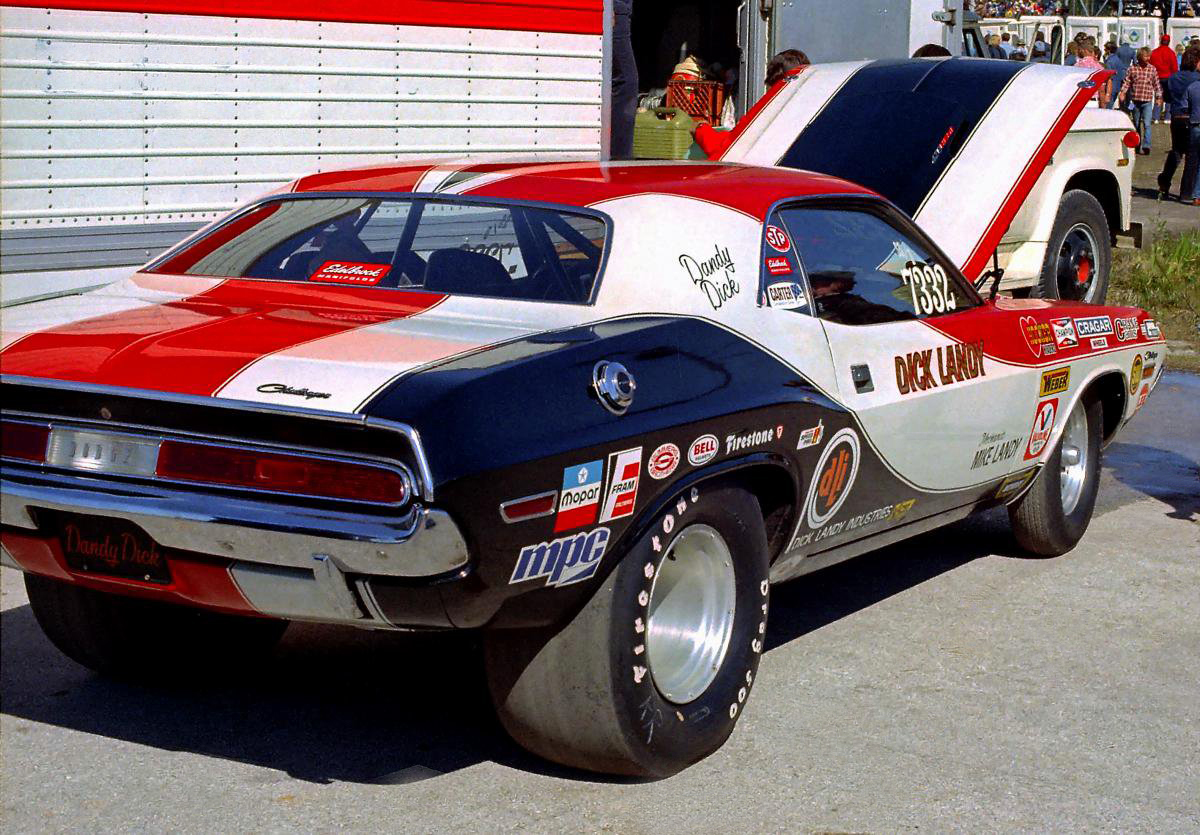
Game change! A one-year-only deal, Chrysler put their contracted drivers into Super Stock cars for 1974 racing action, as a way of boycotting NHRA as a result of the weight break rules that deemed the HEMI engine-powered Mopar vehicles as being uncompetitive, because of all the extra weight added! Landy built and raced this 1970 Challenger equipped with the 426 Street HEMI with a 4-speed, fitting into the Super Stock “D” class category. The car was the Gatornationals class winner that year, plus set the SS/D record at 10.55 seconds. It was fitted with the lightweight “N94” scooped fiberglass hood, which was standard equipment on the 1970 Challenger T/A, plus listed in the dealer order books as optionally available on any V8 Challenger.
CIRCA 1976: PRO STOCK DART SPORT REPLACEMENT CAR
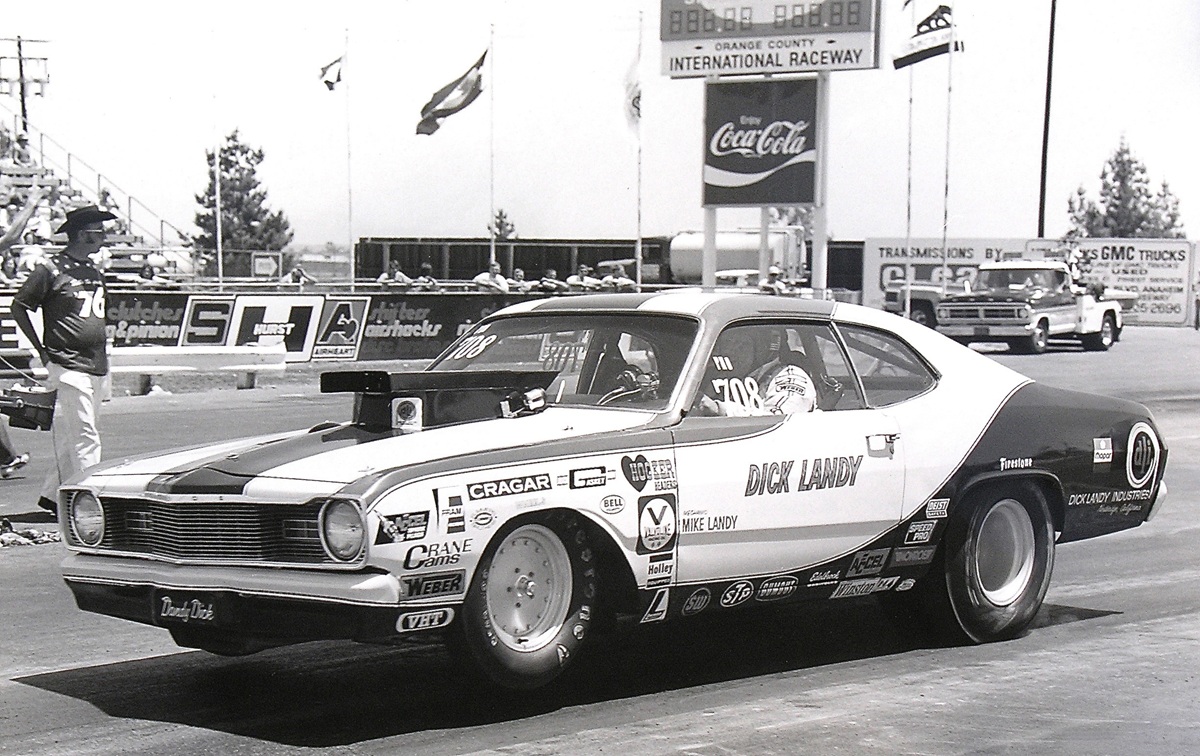
Here’s Dick Landy launching his #2 Dart Sport that he had bought back from Larry Huff (the Soapy Sales / Dyna-Gym Muscle Car). Landy put the car into his trademark paint and colors and continued racing, and by the time 1977 season rolled around, the car ran in the low 8.70s in excess of 157 mph. Here’s what Landy had said about the car in a previous interview back in the day: “I lost a wheel and crashed the first one, I had built that car for Larry Huff at the same time I had built my own, and he sold it back to me. As soon as I got it, we took all the stuff we had learned on the first one and changed the car over. We put a whole new rear suspension under it. I drove the car a few more years. It was the final car I toured with as a driver.”
1979: DODGE OMNI
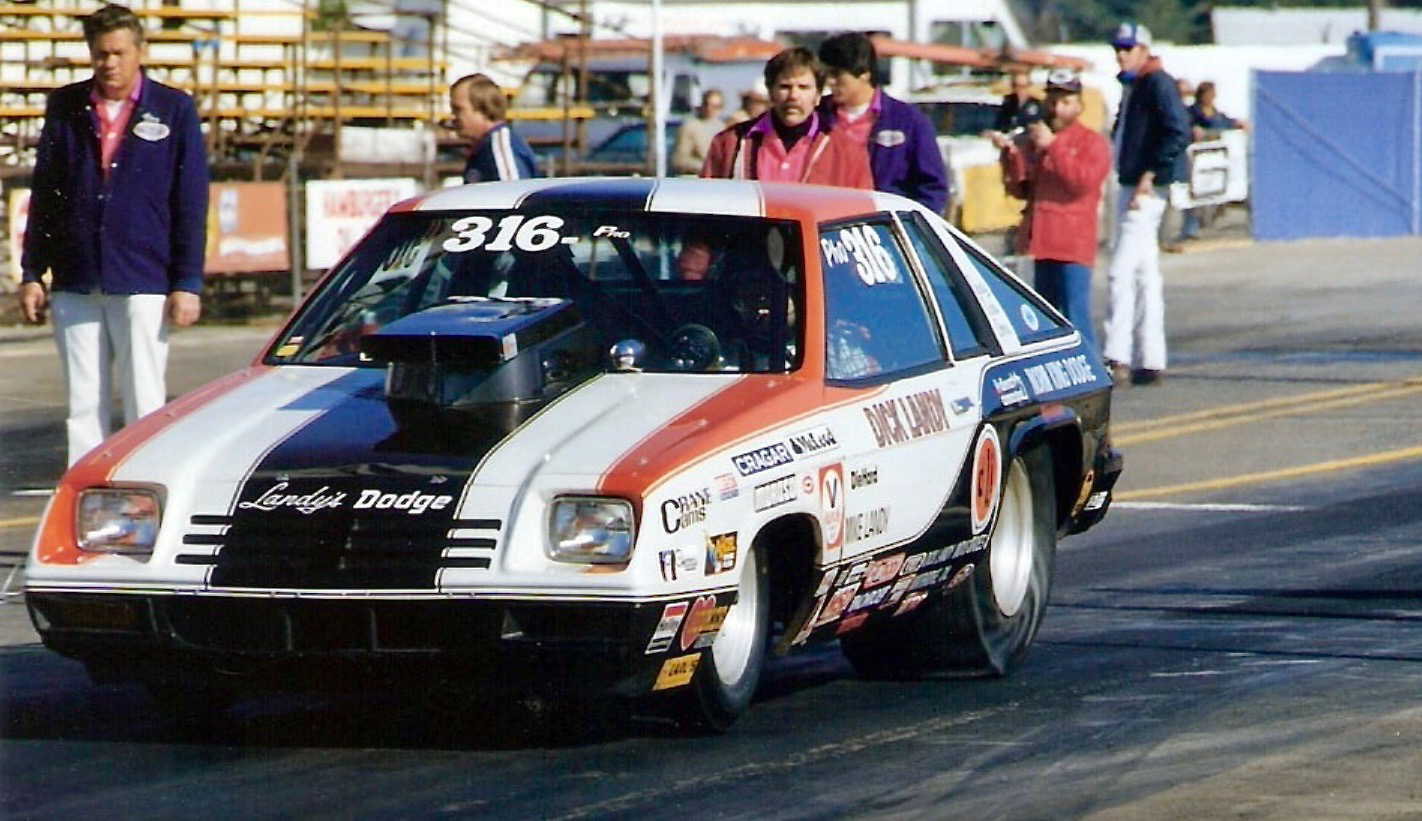
For the 1979 model year, Dodge introduced a subcompact 3-door hatchback coupe called Omni 024, a front engine, front-wheel-drive car to compete with the imports. The small shape of the car was ideal for use of a body in Pro Stock competition, and Landy built his next (and final) Pro Stocker based on the Omni 024 body panels.
Chassis work was done by Don Hardy and the power came from a Chrysler LA-block, highly modified by Landy. The block was modified to do with the lifter bores being changed from 116 degrees to a better angle of 110 degrees, and reworked W-2 Mopar cylinder heads. A ton of work and the ability to withstand 11,300 rpm from its 341 cubic inches. A best time of 8.42 seconds at more than 161 mph! With Brad Yuill and Kenny Dondero sharing the driver seat, Landy finally parked the car in 1981.
Landy shared this about the small block car and the ever-changing weight breaks of the era: “When Glidden did so well with his Arrow (winning the ’79 NHRA World Championship), NHRA took another half-pound off the Fords and gave it to us. That was when I quit for good. I was sick of fighting it.”
(Car shown at Pomona as it was sold to Paul Gentilozzi.)
INDUSTRY RECOGNITION
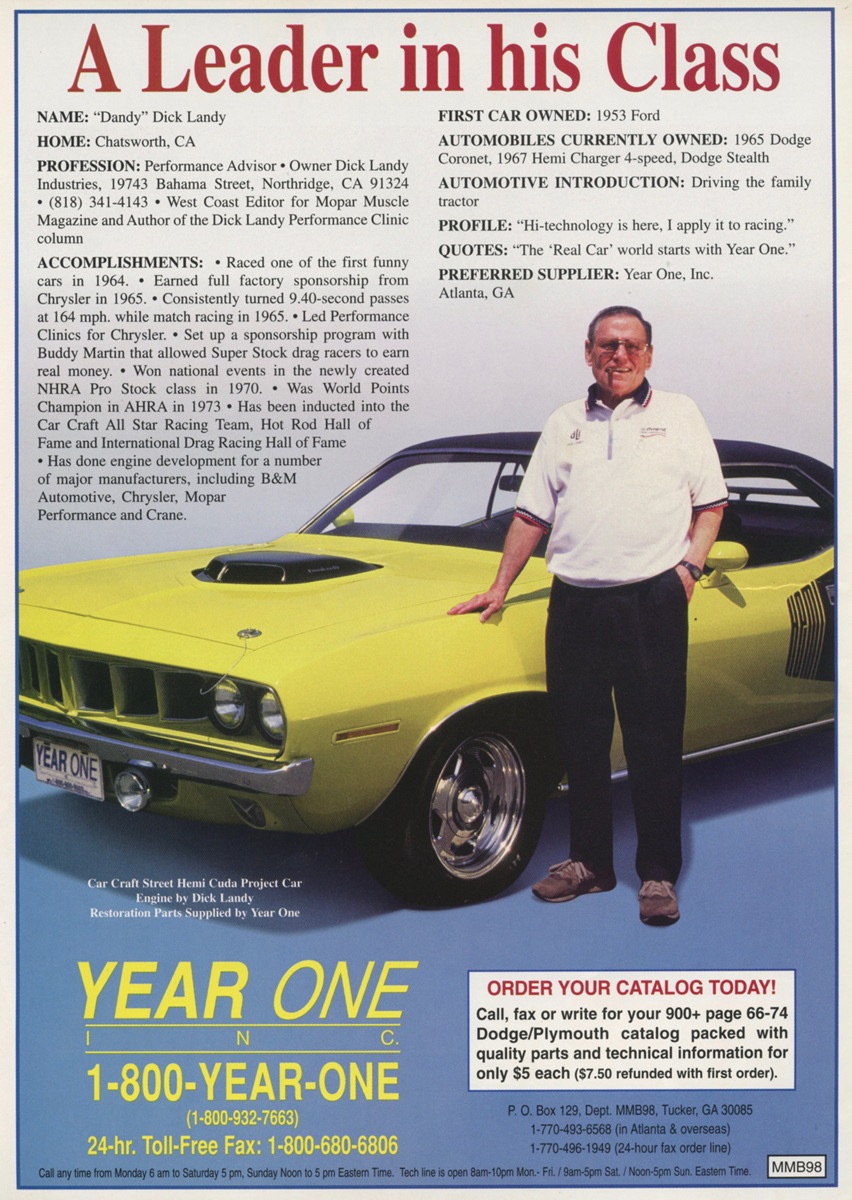
In 1997, automotive restoration supplier Year One, Inc., put together this color ad recognizing Dick Landy’s accomplishments Why have him pose with a Plymouth and not a Dodge? Pictured is the Car Craft magazine’s HEMI ‘Cuda Project Car, fitted with a Dick Landy-built Street HEMI engine.
FACTORY SPOKESMAN
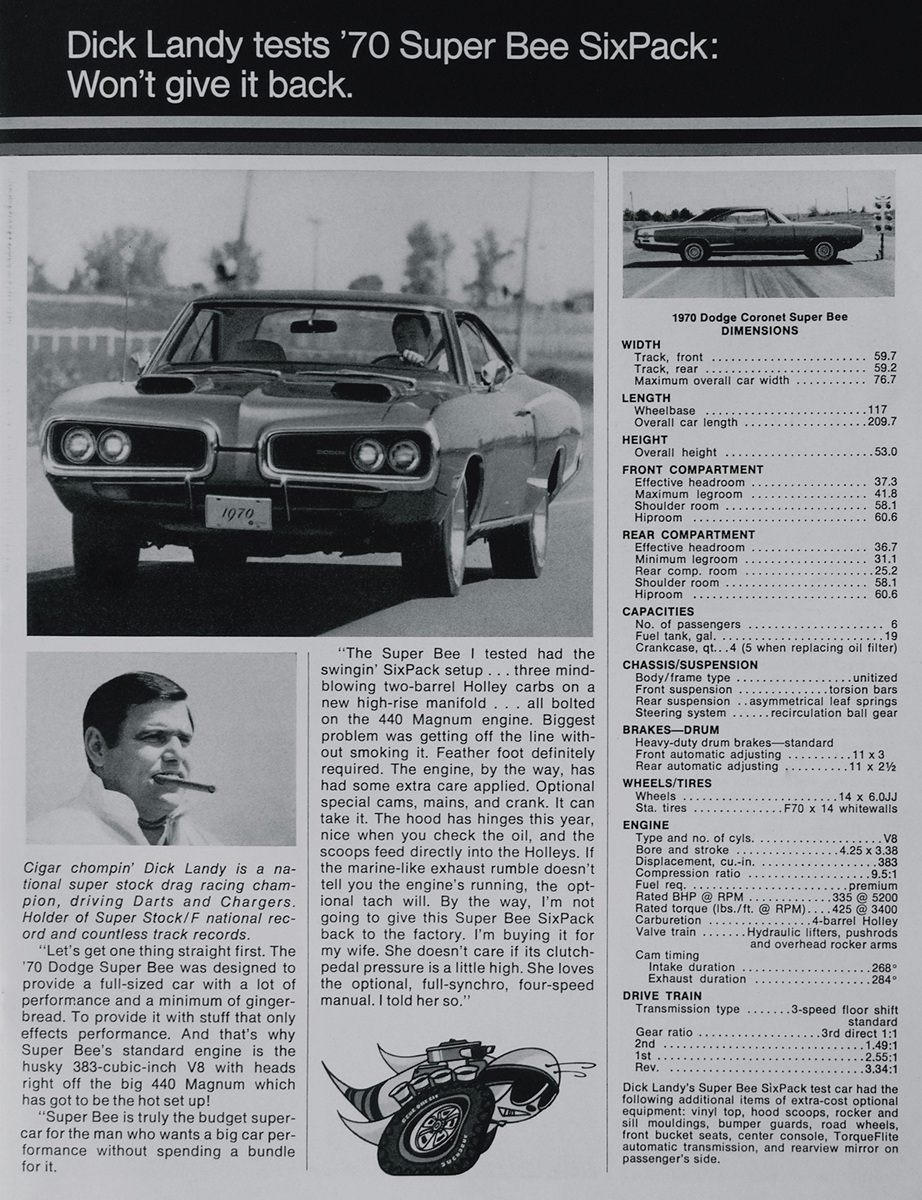
Dodge’s marketing people did incorporate Dick Landy into a number of promotions, in the Dodge News magazine, as well as national magazine advertising campaigns. Between the end of the NHRA 1969 racing season and before the switch to the new 1970 Pro Stock competition, Landy was brought in to test the newly-designed ’70 Super Bee, equipped with the 440 SixPack engine and 4-speed gearbox. The Plum Crazy Purple with White interior was described by Landy as being “a full-sized car with a lot of performance and a minimum of gingerbread. The hood has hinges this year, nice when you have to check the oil. The scoops feed directly into the Holleys.”
In the ad copy, he stated: “By the way, I’m not going to give this Super Bee SixPack back to the factory. I’m buying it for my wife. She doesn’t care if its clutch-pedal pressure is a little high. She loves the optional, full-syncho, four-speed manual. I told her so.”
DLI ENGINE BUILDING
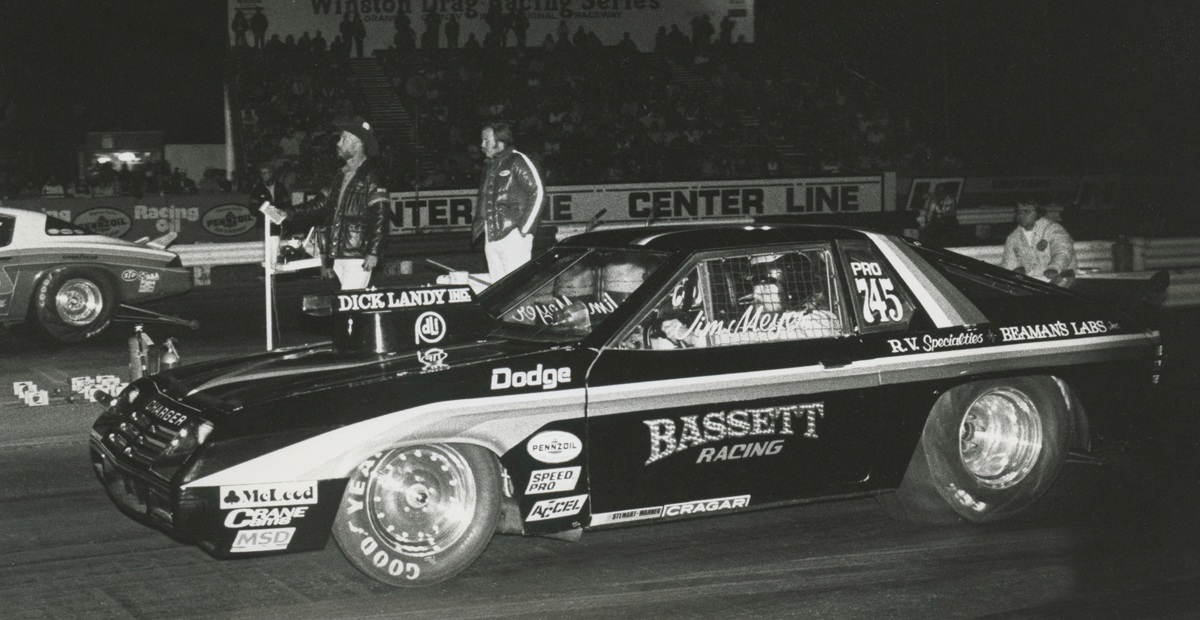
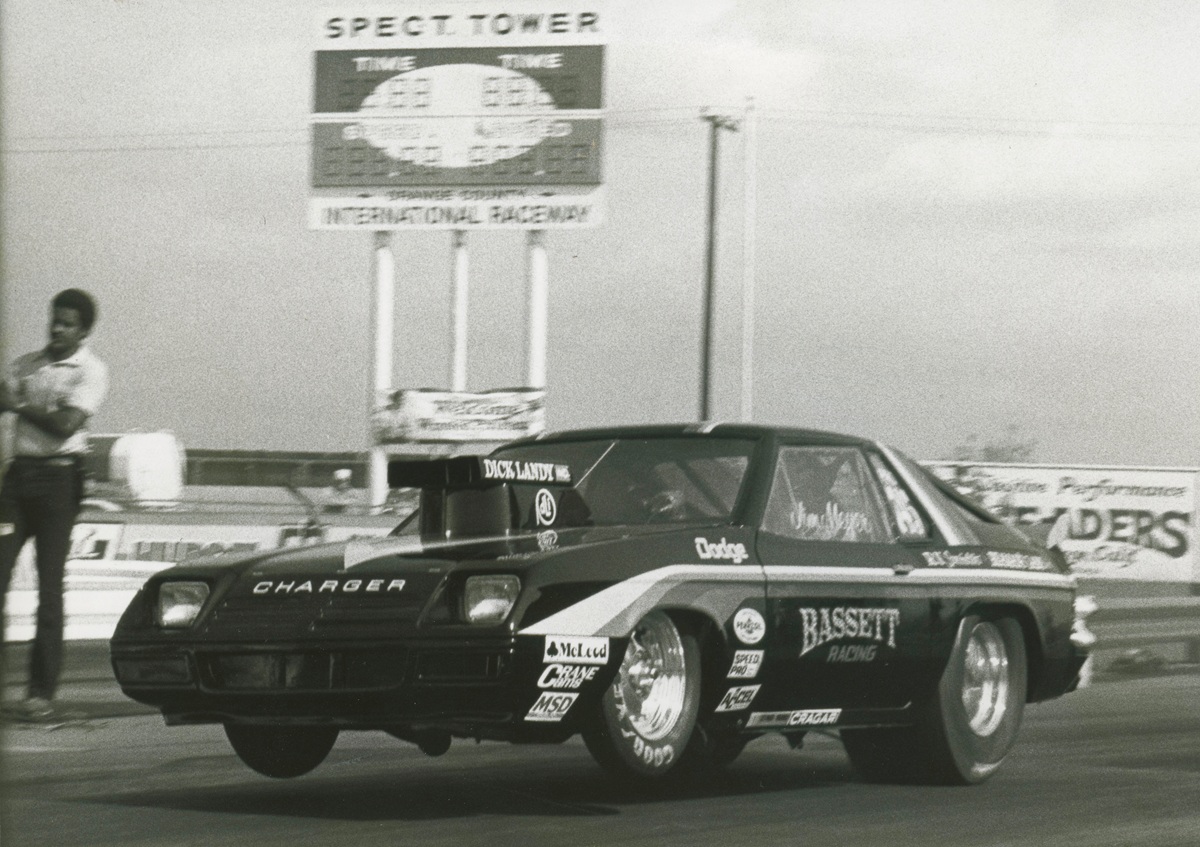
Circa 1982, the Bassett Racing Pro Stock Dodge Omni, Dick Landy D5 HEMI power, Willie Rells chassis, as seen here driven by Jim Meyer at the Orange County International Raceway, East Irvine, CA. Dick Landy Industries did build and supply Mopar HEMI engines to various racers (such as Reid Whisnant) as well as for others, including Roy Hill and his 1984 Mercury Capri Pro Stock. In addition, DLI was working closely with the engineering staff at Chrysler Corporation and with the racing and enthusiast media.
RESTORED LANDY CHALLENGERS
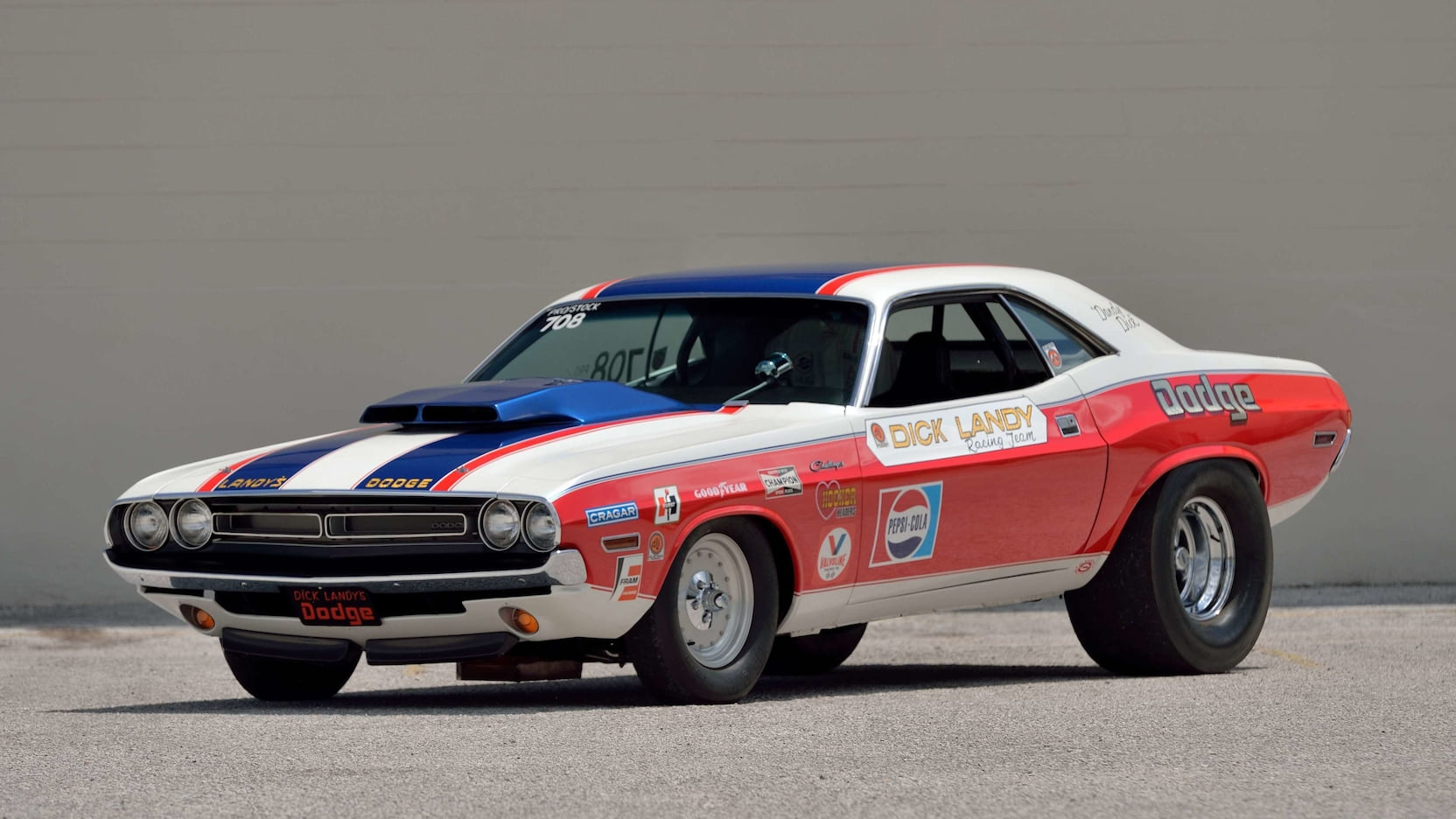
Raced both in 1971 and 1972, this authentic Dick Landy Challenger Pro Stock (now in the 1971 spec and livery) has been fully restored and came out of the Todd Werner Collection for the Mecum 2019 Harrisburg auction.
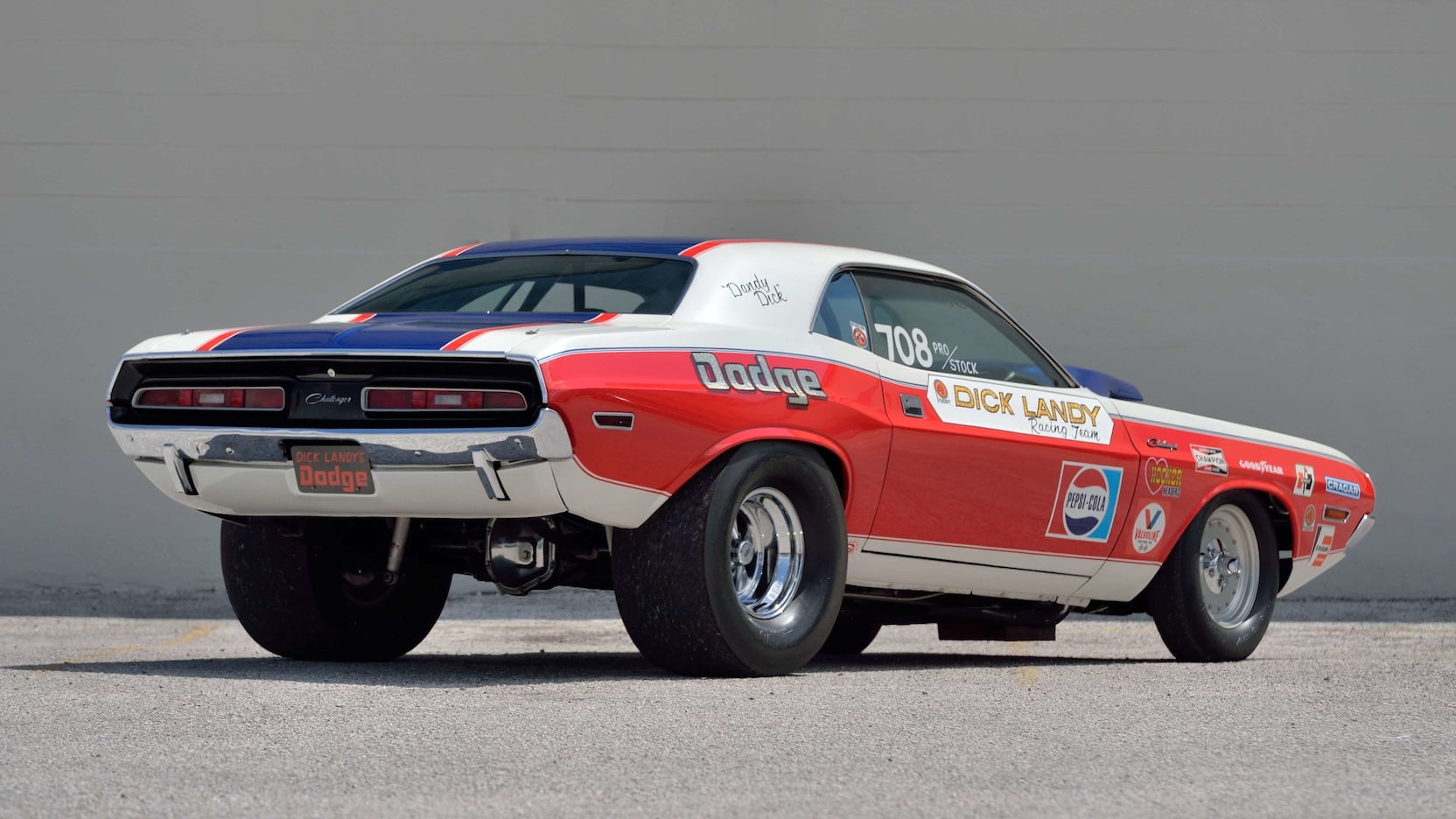
Visible deep oil pan, Dana 60 differential and raked stance were all part of the era.
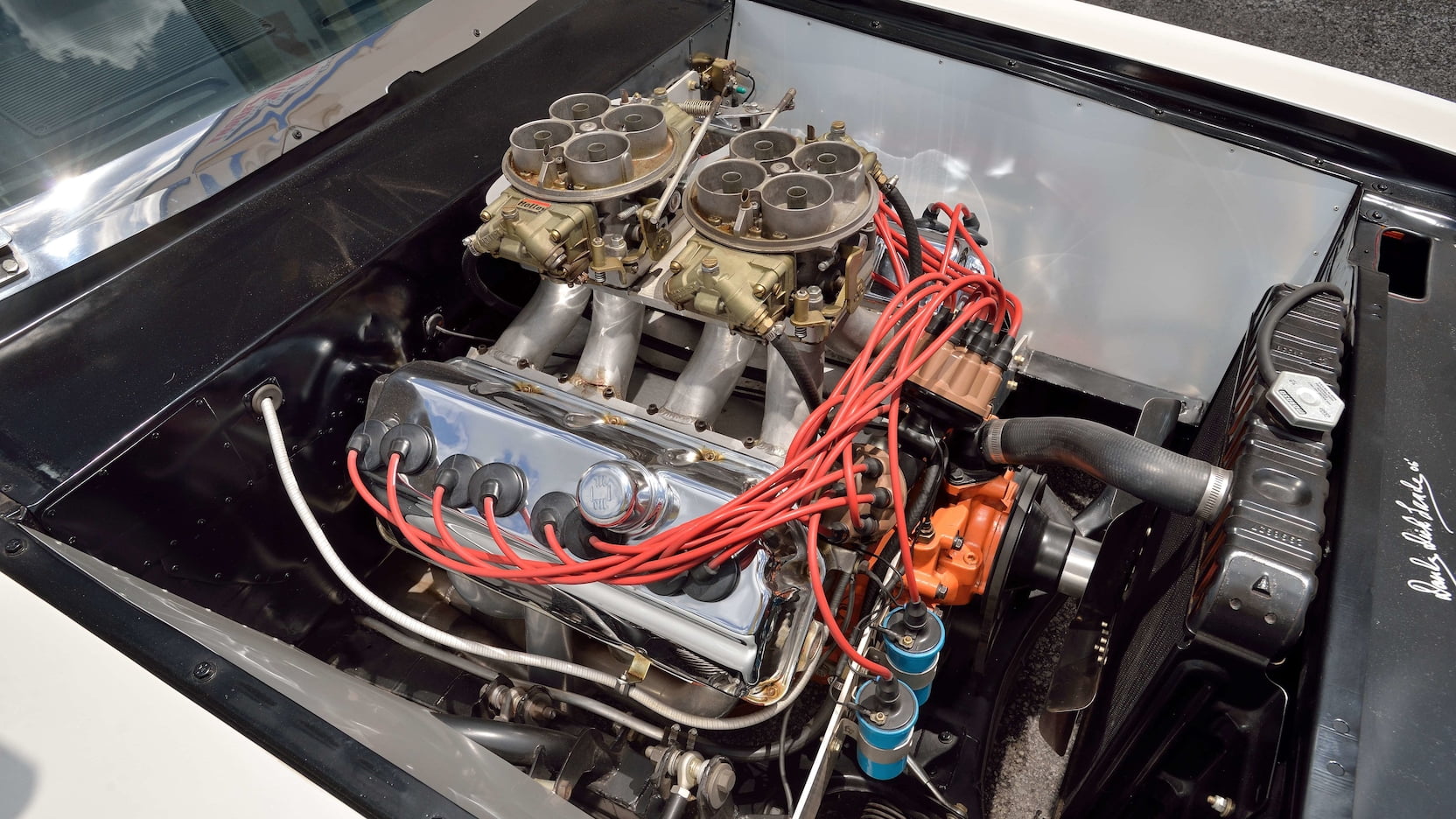
The big HEMI engine with 16 spark plugs, dual Holley Dominators on a fabricated IR (individual runner) intake in all its glory! Look close and you’ll see the “Dandy Dick Landy 06′” signature, validating the vintage racer.
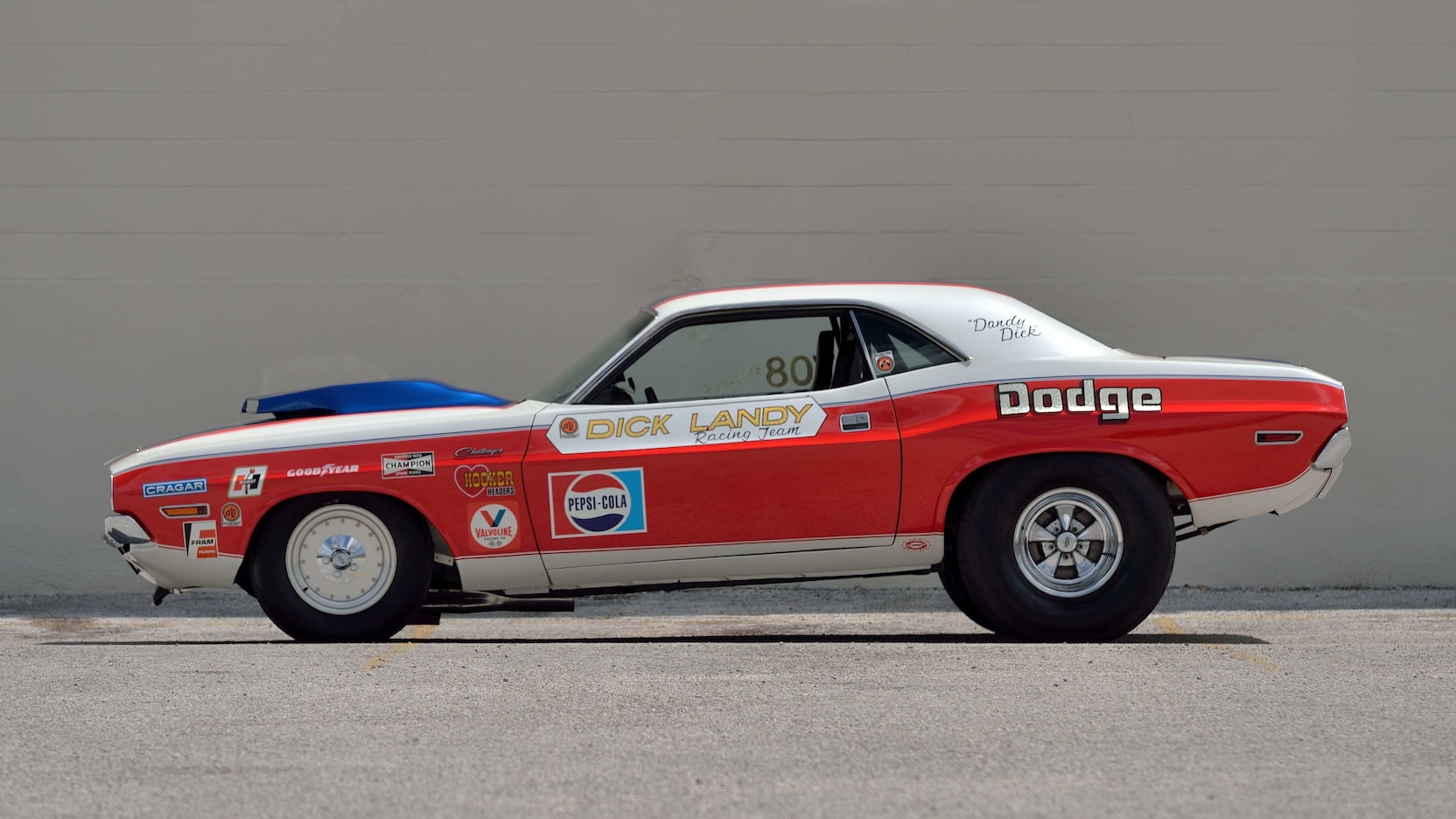
Side shot shows the stretched rear wheel opening and enlarged Challenger T/A hood scoop.
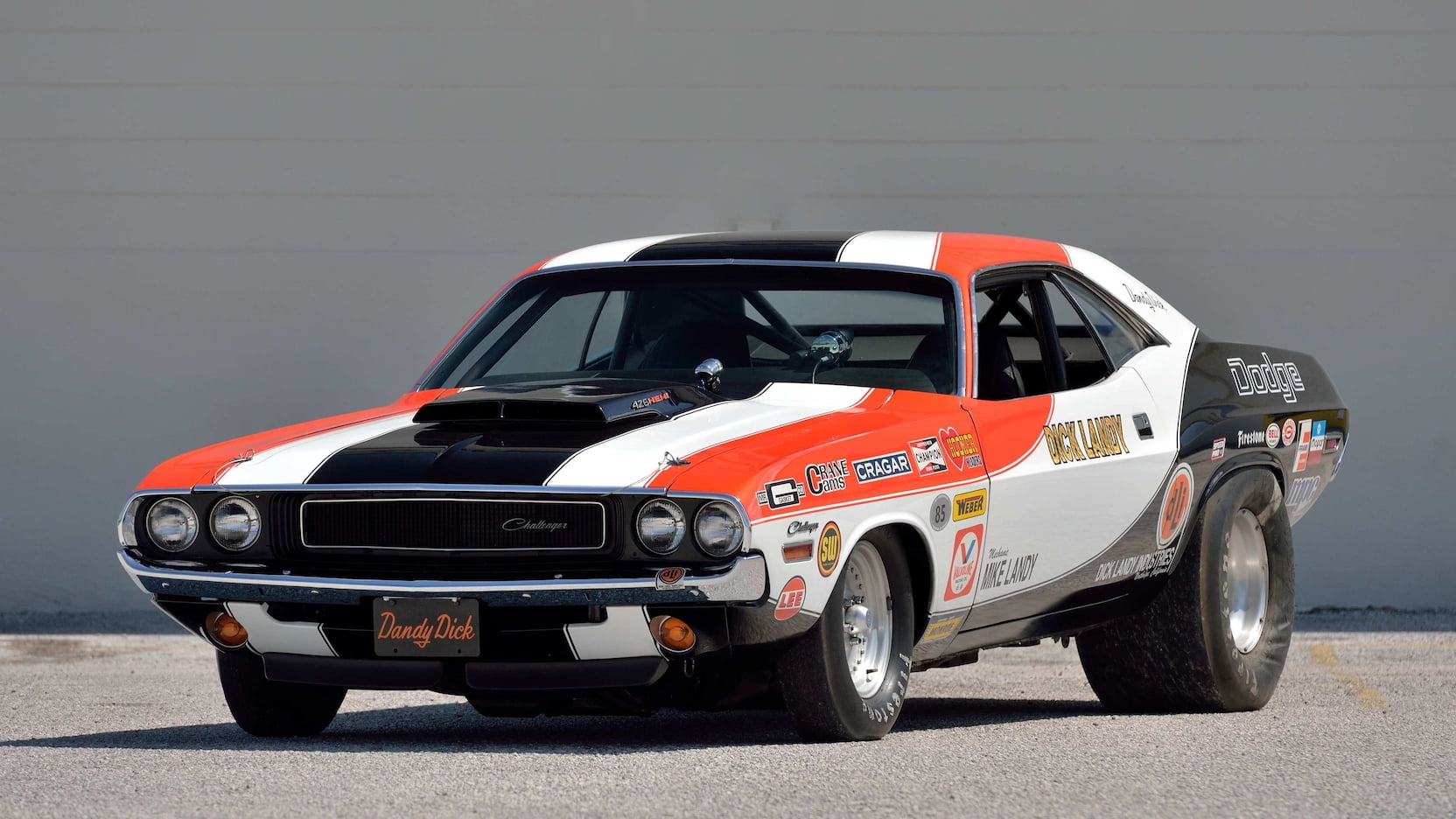
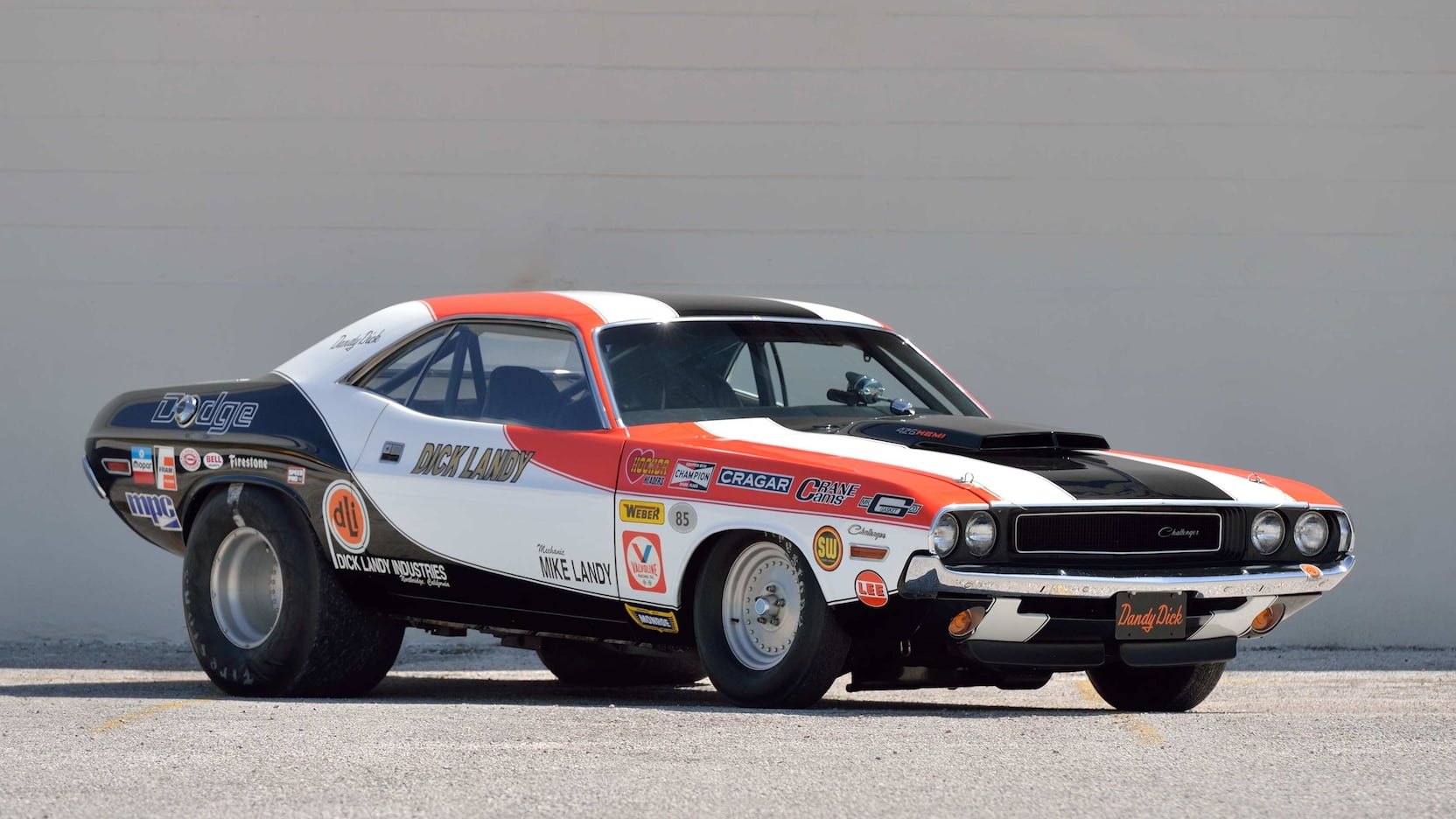
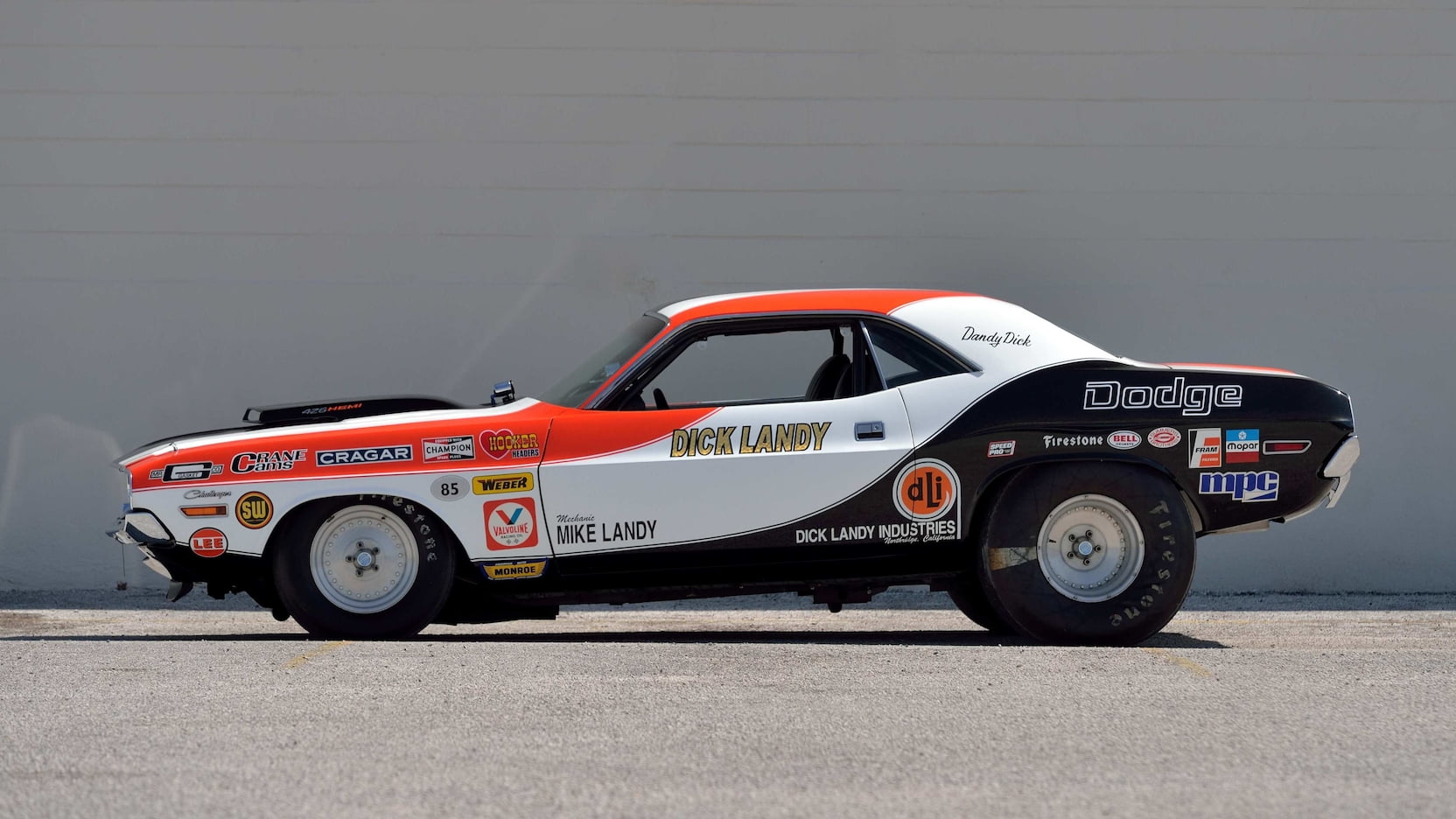
Also part of the Todd Werner Collection, the same auction saw the “boycott” 1970 HEMI Challenger that was set up for Super Stock “D” action, a factory-backed car that Landy himself restored, and later drove the car at the 2001 Goodwood Festival of Speed in England. A very unique situation where he raced the car during the 1974 NHRA season as Chrysler Corporation was protesting the then-current rules in the Pro Stock class.
Richard Joseph Landy 1937-2007
Author: James Maxwell
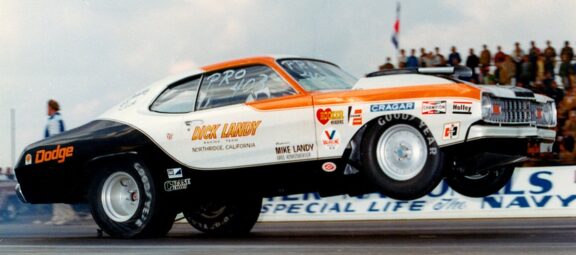
0 Comments